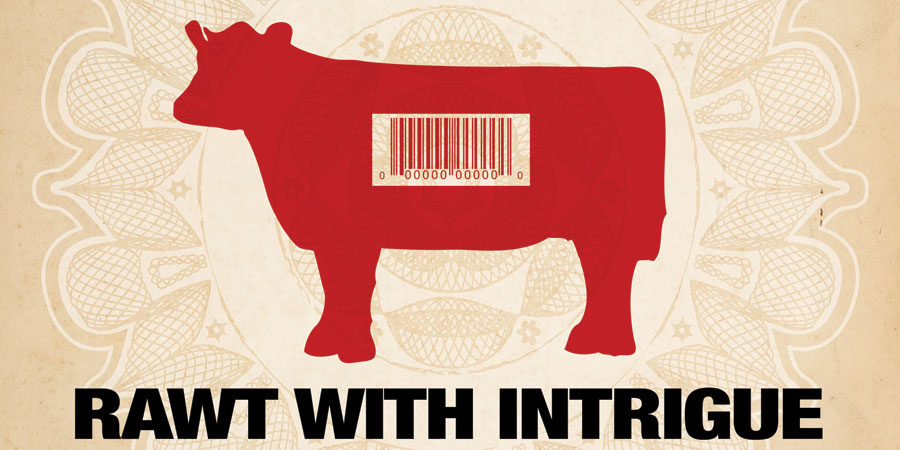The People’s Right to Raw Milk
There is an unspoken sanctity and an inviolable freedom in humankind’s consumption of natural foodstuffs. We have heard the cliché that you are what you eat, but the question of not having the opportunity to choose what we eat, has not, until recently, arose; it was an implicit, inalienable right that the citizenry did not have to fight for. There was no ‘middle man’ to designate the distribution of nature’s product to the consumer. Before driving to the supermarket was the norm, one would walk to the fields and gather what Mother Nature had provided, living off the land in the most natural sense. There was never a contention over the bounties provided by the soil, the planet and the livestock. To consider such things as prohibition, set by the superficial standards of a monopoly was unthinkable and risible – an act of terrorism itself.
Do we now live in times when our independence needs to be so stymied that we are occluded from certain foodstuffs that are healthy for the mind and body? Are the masses, bewildered by constant distractions, destined to be perpetually goaded by a small percentage of aristocrats? When does that imaginary and subjective line between protection and freedom cross into abuse of power?
A perennial question, since time immemorial, has been how much power should be invested in the state for the maintenance of the population – checks and balances as safeguards against corruption. When the government does not have the correct consciousness or knowledge of the salubrious and congenial welfare for the people they are elected to serve; certainly chaos, frustration, and discord are spawn. Rather, they, the people in power, become a burden, another obstacle that the people have to tolerate and carefully avoid like the gangster on the street corner or the panhandler eyeing the tourist’s wallet. Hence, even if the system is intended to prevent the carnal contaminations of its leaders, if the leaders themselves are debased then these safeguards are nugatory; it is simply a sophisticated mob enterprise and no countervailing force is there to uphold the proper rules of conduct.
What is the relevance of this raillery? In today’s so-called ‘free’ market, ‘free’ democracy, and the popular hype of just being a ‘free’, there are ever increasing sanctions for how one is required to live and maintain one’s livelihood, and the more recent tidings reflect the stringency: a perpetual effort by national and state authorities to control the consumption of raw and organic foods. One of the main targets is the distribution of raw milk.
Milking the Facts
The main antagonists advocating the ban on raw milk distribution say that between 1993 and 2006, an average of 116 illnesses a year was contracted because of drinking raw milk. However, when this is compared to the total number of people who contact food-borne illnesses every year, roughly about 76 million, is less than 0.000002%. Furthermore, when looking at the number of illnesses stemming from pasteurized milk, the discriminating mind can find it to be not only much greater, but also lethal. For example, although no one has died from the consumption of raw milk, three people in the state of Massachusetts alone in 2007 died from pasteurized milk. Sally Fallon Morell, president of the Weston A. Price Foundation and founder of “A Campaign for Real Milk,” flatly rejects many of the reports linking illness to raw milk, saying that they are highly biased studies and never actually proved causation of raw milk with illness. Furthermore, she contends that raw milk has not caused death whereas pasteurized milk has certainly been responsible for the death of some people.
There are many benefits akin with the consumption of raw milk, despite putatively accepted to be the opposite. Raw milk has all 20 standard amino acids, 8 essential amino acids necessary for building protein, magnesium, over 60 functional enzymes as well as trace minerals, fats, fatty acids, and vitamins A, D, C, and B. In this way raw milk maintains the body very nicely, protects it from disease, and is particularly advantageous for the proper development of growing children.
It is indeed a complete food, even used for medicinal purposes. Formerly known as the ‘stem cell’ of foods, doctors in the early 20th century used raw milk from grass-fed cows to cure some serious chronic disorders such as tuberculosis, prostate disease, kidney disease, chronic fatigue, diabetes, and even obesity. Written records delineate that the use of raw milk as a panacea extends back much further; however, to the time periods of Hippocrates and Galen and is considered to be a staple for human civilization no less than 30,000 years ago. (www.drrons.com/raw-milk-history-health-benefits-distortions. htm)
Unfortunately, when milk is pasteurized and homogenized many of these nutritious elements are destroyed for the goal of preventing the milk from souring and possibly containing disease-carrying germs. However, as a result of pasteurization, up to 50% of the essential nutrients are destroyed, as well as, ironically, causing more potential health problems for the consumer by removing vitamin C and natural enzymes that kill pathogens, and thus making the milk more susceptible for the growth of unhealthy bacteria; in addition, the calcium content becomes insoluble, leading to maladies such as rickets, nervous troubles, and bad teeth. Twenty percent of the iodine originally present in unadulterated raw milk is also removed, causing constipation. Studies have also shown higher rates of tuberculosis among children who drink pasteurized milk on a regular basis. Homogenization, another human-made process that breaks down butterfat in raw milk, has been shown to be linked with heart disease. Furthermore, if one looks again at the annals of recent human history, one will find that prior to the pasteurization and homogenization of milk in the 1800’s; milk allergies were not an issue for people, but are common today. It is indeed self-evident that chemically changing raw milk causes an abundance of health concerns.
Food Fight
Underlying the struggle between raw and pasteurized milk are big businesses controlling the dairy industry that have a vested interest in pasteurization. The Center for Disease Control, the Department of Food and Drug Administration, the American Medical Association, the Academy of Pediatrics, and the American Veterinary Medicine Association are in solidarity over banning raw milk, claiming that it is dangerous to consume and denying its salubriousness. However, the bare fact of the matter is that goliath industrial dairy industries, financially threatened over the growing popularity of raw milk, cannot safely produce it and are in cahoots with these national health organizations. The cows that live in these factories are unhealthy because they are forced to eat grains, an unnatural diet for cows, and live in unbearable environments, their bodies mutilated to varying degrees, made to stand in their own manure with no space to graze.
According to David Gumpert, author of The Raw Milk Revolution, regulation is “not about safety – it’s about protecting markets.”
Recent raids on health food stores and farmers selling raw milk have highlighted this domestic war. In 2011, Rawesome Foods in Los Angeles was raided by a swat team in conjunction with the Food and Drug Administration, the Department of Agriculture, and the Center for Disease Control. Not only did they raid the store with a fully armed swat team and dump hundreds of gallons of milk and stocks of food, but they disabled security cameras to prevent other infractions from being recorded. A number of similar raids have been conducted by the Food and Drug Administration since 1983, detailing a lengthy list of picaresque activities.
A Spoiled System
From time immemorial in human society there has been a relationship between the supplier and consumer that was based upon, either genuinely or superficially (assuming no sane person would willingly agree to be cheated), mutual exchanges of one thing for another. In bygone times a barter system of one good in exchange for another equally valuable good was the means of survival and basis of the economy. Similarly, during the contemporary period the value of the currency in exchange for an item of esteemed equal value is used in place of the previous barter system; although, the value of either the currency used or the product purchased has become precarious and increasingly difficult to ascertain.
As the population within a constrained geographical region increases, the system of exchange between the supplier and consumer can also increase in complexity. For example, in the modern day many foods on the market are inspected by different intermediary groups before the consumer is able to purchase it; however, people living in towns with considerably less population density than cities are more apt to buy food directly from the farmer’s market or grow their own. It is a much more personal system that is based on the intimate relationship between the farmer, the land, and the consumer; as opposed to an impersonal relationship between the consumer and the personified corporation.
In servicing a large and diverse population there is great pressure upon state and government agencies to set standards and regulations of quality and health. The annals of history reveal that as markets became more impersonal due to increases in population and food manufacturing developed from changes in technology, greater regulations by experts were deemed necessary. Indeed it is pragmatic to have such controls to properly manage the multitudes and discourage cheaters from taking advantage of unwary citizens. Hence, food quality control concerning what foods enter the market, their nutritional properties, and how the food is produced, handled, shipped, and sold to the consumer are necessary given the circumstances.
A balanced approach that uses intelligent discrimination rather than inflexible mandates is necessary to prevent a system, based on idyllic intentions, from becoming tyrannical. Industrial society favors the chemical treatment of milk and other foodstuffs primarily because such inorganic foods are congenial for selling to people on a mass scale. Organic foods, which tend to spoil over a short period, do not have the same marketability. Meanwhile, in the wake of the shift from organic to inorganic as the societal norm, there is propaganda peddled by corporations as well as national and federal institutions that chemically modified food is healthier than organic food – in the case of raw milk, even dangerous to consume.
If these institutions like the Food and Drug Administration, which are entrusted to protect us, do not provide accurate, unbiased information, then they have plainly failed in their mission to protect and serve the people. Furthermore, if the people choose to opt for organic food, albeit outside the parameters of industry standards but still within health safety standards, and are forced to desist without due reason, then it is self-evident that regulators are ineffective in balancing the needs of the individuals with that of the collective.
Cow is Mother
The tainting of the cow’s milk is another symptom of mistreatment towards cows in general. At the present time, cows in the Western world are treated with a singular, univocal paradigm: as objects for sense gratification devoid of any personal quality. Cows are force-fed an unnatural diet, locked in stygian living conditions, and treated like the meat or piece of leather that they are destined to become in the near future. Indeed, it is a hellish condition made by humans for their touching and tasting sense pleasure. Their justification is ‘for my pleasure’ and the means is by way of torture and blood shed. How does one define a person who is solely dedicated to personal, material attachments and is at the same time without any conscious understanding of other beings’ welfare or a logical and objective moral standard? That is the definition of a criminal and psychopath. Few are aware that in the attempt to manipulate nature for greater happiness, they are in fact blighted with something inferior and increasingly difficult to maintain.
According to Srila A.C. Bhaktivedanta Swami Prabhupada, a great spiritual leader and saint, “The cow is the most important animal for developing the human body to perfection. The body can be maintained by any kind of foodstuff, but cow’s milk is particularly essential for developing the finer tissues of the human brain so that one can understand the intricacies of transcendental knowledge. A civilized person is expected to live on foodstuffs comprising fruits, vegetables, grains, sugar, and milk. The bull helps in the agricultural process of producing grain, et cetera, and thus in one sense the bull is the father of humankind, whereas the cow is the mother, for she supplies milk to human society. A civilized person is therefore expected to give all protection to the bulls and the cows.”









